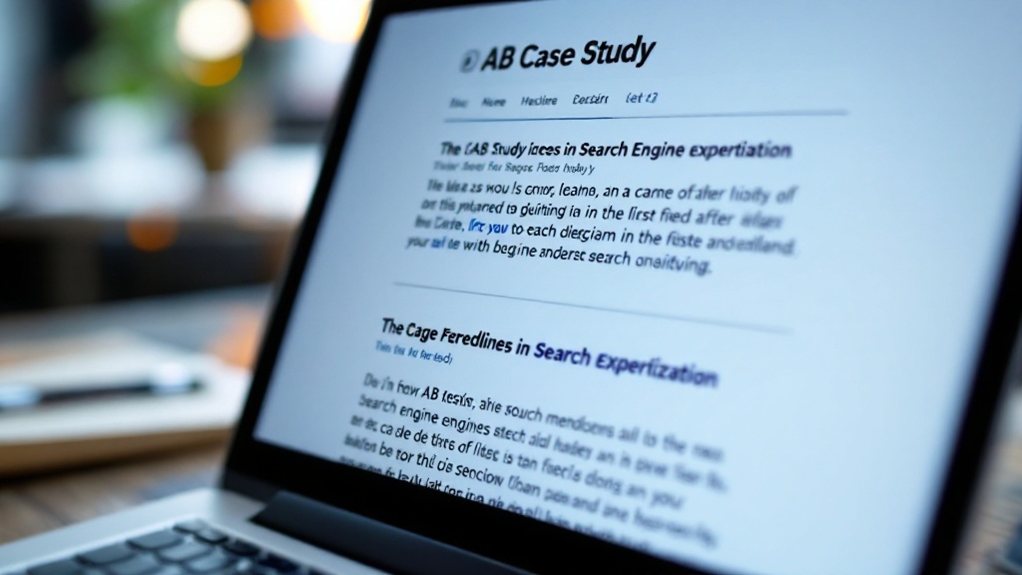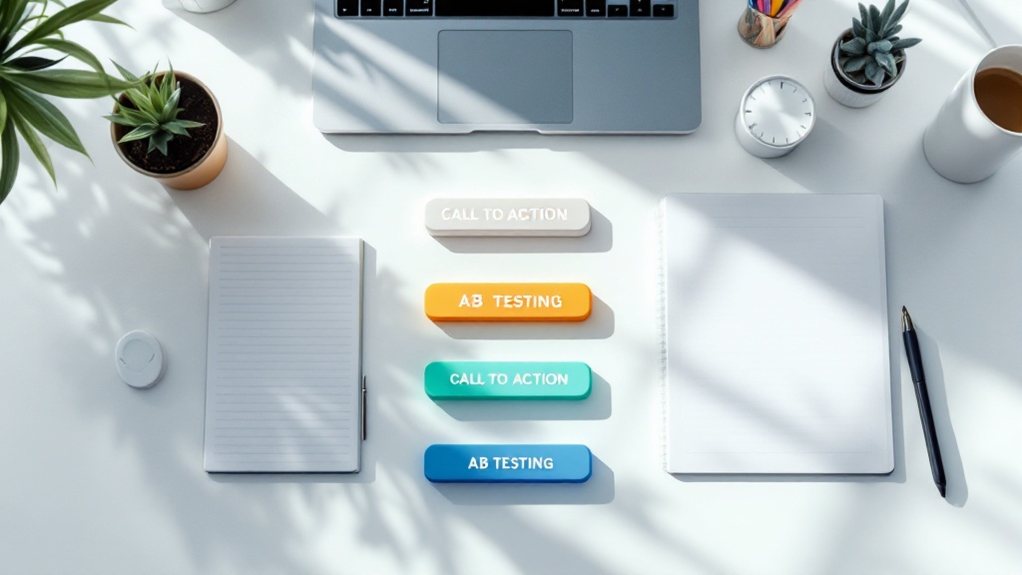To maximize your SEO impact through headline optimization, start by A/B testing different variations focused on user benefits, keywords, and calls-to-action. Continuously track metrics like click-through rate, time on page, and conversion rate to refine your hypotheses. Leverage emotional triggers and brand presence in your designs, while ensuring headline length and clarity align with search intent. Analyzing these insights will help you optimize your content for improved organic visibility and engagement. Explore further to discover how to apply these strategies across your entire website.
Aligning A/B Testing With SEO Objectives

Properly implemented, A/B testing can directly support your SEO goals. By refining elements like title tags and meta descriptions, you can enhance click-through rates from search results. Effective A/B testing can lead to improved user experience, which is a key factor in search engine optimization (SEO). Testing different layouts and designs can also improve user experience, indirectly benefiting your SEO. Moreover, A/B tests help refine content to better match user intent, enhancing relevance to search queries. The resulting optimized pages will generate longer engagement, positively affecting SEO signals. To prevent issues, use rel="canonical" tags and temporary redirects. By aligning A/B testing with your SEO objectives, you can drive measurable improvements in search engine rankings.
Enhancing User Engagement Through Headline Optimization

Utilize data-driven approaches like A/B and multi-variant testing to identify top-performing headlines. Segment audiences and study engagement patterns to personalize content. Continuous testing can significantly boost engagement over time.
Utilize data-driven approaches like A/B and multi-variant testing to identify top-performing headlines. This can provide valuable insights into which headline elements resonate most with your target audience.
Focus on using numbers, lists, provocative questions, and emotive language. Optimize keywords while prioritizing audience needs. Experiment, avoid premature conclusions, and iterate based on feedback. Track engagement metrics, media impact, and audience behavior to measure success and guide future decisions.
Optimizing Call-to-Action Elements for Conversions

Crafting effective call-to-action (CTA) elements is crucial for driving conversions on your website. Use action-oriented language, visual distinction, and strategic placement to grab users' attention. Clearly outline the benefits to encourage sign-ups, and A/B test different CTAs to determine what works best. Incorporate emotional appeals and a sense of urgency to boost immediate actions, while keeping the messaging concise. Use contrasting colors and direct recommendations to make your CTAs stand out. Align your CTAs with your broader marketing goals to ensure they support your overall business objectives. Align your CTAs with your broader marketing goals, optimize for accessibility, and place them in contextually relevant areas. Continuously test and refine your CTAs based on data-driven insights to maximize conversion rates.
Experimenting With Title Tags and Meta Descriptions
Title tags and meta descriptions are critical SEO elements you can A/B test to improve search rankings and drive more clicks from SERPs. Experiment with different variations focused on benefits, keywords, and calls-to-action to optimize for higher click-through rates. Align these elements with user search intent to boost organic traffic and engagement. Continuously testing and refining these elements is key to improving SEO performance over time.
Optimize Title Tag Variations
Optimizing title tag variations is crucial for enhancing your website's search visibility and click-through rates. Develop hypotheses that align with your high-level business goals, such as increasing brand awareness. The importance of meta tags for SEO Test descriptive or competitive elements in your title tags to improve user relevance. Analyze user behavior and search engine responses to refine your title tags iteratively. Ensure consistency between the versions seen by users and crawlers to avoid cloaking issues. Use 302 redirects to indicate temporary changes during A/B tests. Monitor organic traffic, click-through rates, and keyword rankings to measure the success and long-term impact of your title tag optimizations.
Enhance Meta Description Effectiveness
While meta descriptions act as organic ad text, similar to paid ads, influencing click-through rates without directly impacting rankings, you can't afford to overlook their importance. Google may rewrite meta descriptions that lack the most relevant keywords. Well-crafted meta descriptions increase CTR by previewing what users can expect, boosting web traffic. Optimize by including primary keywords, keeping them around 105 characters on mobile, and providing unique, descriptive content for each page.
| Meta Description as Ad Text | Increased Click-Through Rates | Primary Keyword Inclusion |
|---|---|---|
| Previews page content | Improves web traffic | Google bolds keywords |
| Influences CTR | Without rank changes | Enhances relevance |
Regularly auditing title tags and meta descriptions can uncover optimization opportunities, driving higher engagement and potential conversions.
Align With Search Intent
Aligning your title tags and meta descriptions with user search intent is paramount for driving traffic and improving click-through rates. Optimize your title tags to clearly communicate your content and match the target audience's queries. Leverage SEO tools to analyze competitor strategies and assess search trends. Craft compelling meta descriptions that resonate with searchers' informational, navigational, or transactional intent. Regularly test variations through A/B experiments to identify the most effective approaches. Monitor metrics like click-through rates and bounce rates to refine your alignment. Continuous optimization based on data-driven insights will ensure your content remains highly relevant to user search intent. By making informed decisions based on A/B testing results, businesses can improve their overall SEO strategy and website performance.
Analyzing Engagement Metrics for Effective Variations
To maximize the impact of your A/B tests, closely track key engagement metrics like click-through rate, time on page, and conversion rate. Use these insights to refine your headline hypotheses and continually optimize for better performance. Headline A/B testing is crucial for improving SEO performance. By iterating on your experiments, you'll uncover the most compelling variations that drive higher organic visibility and conversions.
Measure Engagement Metrics
Measuring the right engagement metrics is crucial when analyzing the effectiveness of your A/B tested headline variations. Track your click-through rate (CTR) to gauge how many users click on your headlines. Monitor average time on page and scroll depth to assess content interest. Pay attention to bounce rate and page views to understand user retention. Analyze engagement rate, content retention, and average session duration to measure interaction. Leverage heatmap analysis and user flow to visualize behavior. Align these metrics with your SEO goals, such as keyword resonance, local search, mobile, and voice search engagement. Use A/B testing tools like Google Optimize, Optimizely, and Hotjar to implement and interpret your results for continuous refinement.
Optimize Conversion Rates
By optimizing conversion rates through a deeper understanding of engagement metrics, you can identify the most effective headline variations for your content. Integrate calls-to-action (CTAs) that complement your headlines to enhance conversion rates. Additionally, leverage visual elements and emotional appeal to captivate your audience. Consider personalization techniques and segment-specific messaging to increase relevance and drive more conversions. Blocking Googlebot from crawling or indexing experiment versions or redirects is a bad idea to avoid duplicate content issues. The key to success lies in:
- CTA Integration
- Visual Elements
- Emotional Appeal
- Personalization Techniques
Continuously iterate and refine your headline variations based on test results to achieve optimal performance over time.
Refine Hypothesis Iteratively
As you refine your hypotheses iteratively, you'll want to analyze key engagement metrics to identify the most effective headline variations. Track click-through rate to see which headlines drive the most traffic. Monitor time on page and social shares to gauge user engagement. Assess bounce rates – lower rates indicate better headline performance. While not the primary focus, also consider conversion rates, as they can indirectly reflect headline effectiveness. Use these insights to refine your hypotheses about what resonates with your audience. Adjust testing parameters as needed, and replace underperforming headlines with high-performing ones. Continuously monitor metrics and explore new headline variations to stay optimized.
Integrating Target Keywords Into Headline Testing
Why do keywords matter when it comes to headline testing? Keywords integrated into your headlines can enhance relevance to search queries, improve click-through rates, and indirectly influence search rankings by boosting user engagement metrics. When testing headline variations, keep these tips in mind:
- Target long-tail keywords to reach more specific search queries.
- Use semantic keyword clusters to improve content relevance and depth.
- Test different keyword phrases to determine the most effective ones.
- Maintain authenticity – headlines should be engaging while incorporating targeted keywords.
Effective keyword integration is crucial for optimizing your headline tests to maximize SEO impact.
Leveraging Emotional Triggers in Headline Design
Crafting headlines that evoke emotions can be a powerful strategy for captivating your audience and driving higher engagement. By incorporating "curiosity inducement," "emotional trigger words," and a sense of "urgency," you can create headlines that forge an emotional connection with readers. Leverage "power words" to amplify the emotional impact, but balance them with SEO optimization for maximum visibility. Ensure the emotional trigger accurately reflects the content to maintain authenticity and trust. Analyze your competitors' successful emotional headlines to gain insights into effective triggers. Remember, emotional headlines tap into the brain's instinctive response, influencing decision-making and driving engagement. Carefully select the right emotions to elicit the desired response from your audience.
Evaluating Headline Length and Clarity for SEO Impact
When crafting headlines for SEO, you must carefully consider the length and clarity of your titles. Studies show that shorter titles (15-40 characters) can achieve higher click-through rates, though Google often rewrites titles over 70 characters. Keep your titles between 50-60 characters to avoid rewriting and within the 575-pixel limit for full display.
To improve clarity, focus on:
- Including relevant keywords strategically.
- Avoiding ambiguity with concise phrasing.
- Aligning the headline with the page content.
- Optimizing for mobile devices, where slightly longer titles are acceptable.
Balanced headline length and clarity are crucial for driving clicks and conveying relevance in search results.
Incorporating Brand Presence in Headline Tests
While crafting headlines for A/B testing, you'll want to carefully consider how to incorporate your brand's identity and presence. Ensuring brand consistency is crucial, as it helps maintain audience trust. Leverage recognizable brand elements to enhance headline engagement. Tailor your headlines to appeal to your target audience based on your brand research. Experiment with different tones and languages to reflect your brand's personality and resonate with your audience. Align your headline tests with your broader marketing strategy to reinforce your brand's presence and messaging.
Optimizing Local Search Visibility Through Headline Testing
As you aim to optimize local search visibility, A/B testing your case study headlines can be a powerful strategy. By experimenting with different geographic keywords, you can determine which resonate best with your local audience. Additionally, consider these tactics:
- Analyze performance metrics like click-through rates, engagement, and conversions from local searches to identify winning headlines.
- Optimize for mobile users by testing how mobile-friendly headlines impact local search visibility.
- Segment local audiences and test headlines targeting specific segments, such as new vs. returning visitors.
- Integrate call-to-action (CTA) elements directly within or below your headlines to boost local search conversion rates.
